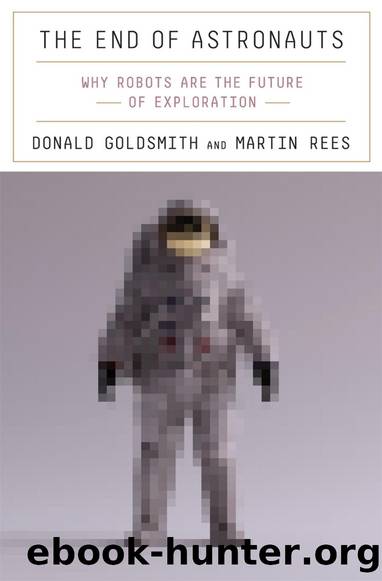The End of Astronauts: Why Robots Are the Future of Exploration by Donald Goldsmith

Author:Donald Goldsmith [Goldsmith, Donald]
Language: eng
Format: epub
ISBN: 9780674257726
Amazon: 0674257723
Barnesnoble: 0674257723
Goodreads: 58885859
Publisher: Harvard University Press
HOW CAN WE PROTECT OURSELVES FROM MARS, AND MARS FROM US?
Today no one doubts that there is a possibilityâwhich some scientists would describe as a likelihoodâof finding life on our planetary neighbor, nestling close to the water that percolates in small degrees at certain sites. Astronomers once judged Mars entirely lacking in water, except for small, transitory amounts at the fringes of the polar caps. Today, however, we observe rivulets of waterâlikewise transitory, to be sureâthat pour over the edges of Martian craters. Most Mars experts believe that in many places, the Martian subsoil contains significant amounts of water. The Perseverance rover is presently exploring Jezero, a thirty-mile-wide crater whose topography identifies it as a former lake, fully filled with water 3.5 billion years ago. Lake Jezero may have borne hosts of flourishing organisms, whose descendants or fossils await our interest. Far better to examine them without muddying the waters, literally and metaphorically, by disturbing their calm existence either physically or biologically. Still better would be not to bring any home that could produce, in an outcome as unlikely as it would be unwelcome, a pandemic fatal to much of the life on Earth.
If we find rocks that may have lain on the bottom of long-vanished Martian lakes, bring them to Earth, crack them open, find bacteria inside, and discover that their DNA matches ours, what should we conclude? If we can rule out pollution, the conclusion follows that life has long existed on Mars, and that in the distant past, life-forms traveled from Earth to Mars, or from Mars to Earth, or from a third object to both Earth and Mars. But if we cannot be sure whether the bacteria in Mars rocks made their journey millions of years ago or only a few years earlier because of equipment that we humans brought to the planet, the confidence that we place in our conclusion shrinks drastically. Biologists could argue about the likelihood that bacteria could find their way into rocks only a few years after they landed on Mars; they could discuss the similarities and differences between terrestrial and Martian bacteria that could determine the possibility of interplanetary identity. Whatâs clear is that pollution by Earth life obviously and inevitably complicates any analysis of living organisms discovered beyond the Earth. Just as clearly, the prevention of such pollution presents a far greater challenge when a human expedition rather than a robotic explorer investigates Mars or any other planet.
Even the most modest exploratory missions necessarily bring a host of organisms from our planet. Fully aware of this fact, NASA and its partners, as we have seen, make significant attempts to sterilize spacecraft sent to the moon, the planets, and the asteroids. Their scientists know that even our best attempts cannot send completely organism-free probes to land on other solar-system objects. As we can easily perceive, the sterilization issue grows many times more difficult with spacecraft that allow humans to disembark, and many times more than that with colonies established for the long term.
Download
This site does not store any files on its server. We only index and link to content provided by other sites. Please contact the content providers to delete copyright contents if any and email us, we'll remove relevant links or contents immediately.
| Automotive | Engineering |
| Transportation |
Whiskies Galore by Ian Buxton(41710)
Introduction to Aircraft Design (Cambridge Aerospace Series) by John P. Fielding(33011)
Small Unmanned Fixed-wing Aircraft Design by Andrew J. Keane Andras Sobester James P. Scanlan & András Sóbester & James P. Scanlan(32678)
Craft Beer for the Homebrewer by Michael Agnew(18072)
Turbulence by E. J. Noyes(7888)
The Complete Stick Figure Physics Tutorials by Allen Sarah(7257)
Kaplan MCAT General Chemistry Review by Kaplan(6811)
The Thirst by Nesbo Jo(6748)
Bad Blood by John Carreyrou(6467)
Modelling of Convective Heat and Mass Transfer in Rotating Flows by Igor V. Shevchuk(6348)
Learning SQL by Alan Beaulieu(6152)
Weapons of Math Destruction by Cathy O'Neil(6074)
Man-made Catastrophes and Risk Information Concealment by Dmitry Chernov & Didier Sornette(5865)
Digital Minimalism by Cal Newport;(5576)
Life 3.0: Being Human in the Age of Artificial Intelligence by Tegmark Max(5395)
iGen by Jean M. Twenge(5293)
Secrets of Antigravity Propulsion: Tesla, UFOs, and Classified Aerospace Technology by Ph.D. Paul A. Laviolette(5231)
Design of Trajectory Optimization Approach for Space Maneuver Vehicle Skip Entry Problems by Runqi Chai & Al Savvaris & Antonios Tsourdos & Senchun Chai(4949)
Electronic Devices & Circuits by Jacob Millman & Christos C. Halkias(4859)
